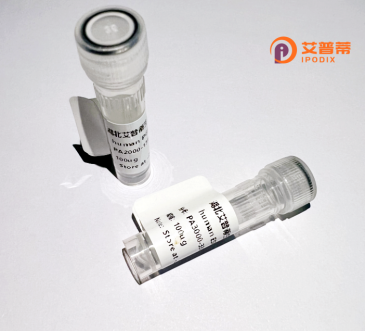
| 纯度 | >90%SDS-PAGE. |
| 种属 | Human |
| 靶点 | CLEC9A |
| Uniprot No | CLEC9A |
| 内毒素 | < 0.01EU/μg |
| 表达宿主 | E.coli |
| 表达区间 | 1-241aa |
| 氨基酸序列 | MHEEEIYTSLQWDSPAPDTYQKCLSSNKCSGACCLVMVISCVFCMGLLTASIFLGVKLLQVSTIAMQQQEKLIQQERALLNFTEWKRSCALQMKYCQAFMQNSLSSAHNSSPCPNNWIQNRESCYYVSEIWSIWHTSQENCLKEGSTLLQIESKEEMDFITGSLRKIKGSYDYWVGLSQDGHSGRWLWQDGSSPSPGLLPAERSQSANQVCGYVKSNSLLSSNCSTWKYFICEKYALRSSV |
| 分子量 | 53.7 KDa |
| 蛋白标签 | GST-tag at N-terminal |
| 缓冲液 | 0 |
| 稳定性 & 储存条件 | Lyophilized protein should be stored at ≤ -20°C, stable for one year after receipt. Reconstituted protein solution can be stored at 2-8°C for 2-7 days. Aliquots of reconstituted samples are stable at ≤ -20°C for 3 months. |
| 复溶 | Always centrifuge tubes before opening.Do not mix by vortex or pipetting. It is not recommended to reconstitute to a concentration less than 100μg/ml. Dissolve the lyophilized protein in distilled water. Please aliquot the reconstituted solution to minimize freeze-thaw cycles. |
以下是关于重组人CLEC9A蛋白的3篇代表性文献,内容涵盖其功能、结构及潜在应用:
---
1. **文献名称**:*CLEC9A is a novel activation receptor on human and mouse dendritic cells*
**作者**:Caminschi, I. et al.
**摘要**:该研究发现CLEC9A是树突状细胞(DC)表面特异性表达的C型凝集素受体,能够识别坏死细胞释放的特定配体。通过重组人CLEC9A蛋白的体外实验,证实其介导交叉抗原提呈功能,为疫苗开发提供潜在靶点。
---
2. **文献名称**:*DNGR-1 is a specific receptor for necrotic cells in the cross-presentation of viral antigens*
**作者**:Sancho, D. et al.
**摘要**:本文阐明CLEC9A(DNGR-1)通过结合坏死细胞中的肌动蛋白丝状结构,触发DC的抗原交叉提呈通路。研究中利用重组CLEC9A蛋白揭示其结合配体的结构特征,表明其在抗病毒免疫中的关键作用。
---
3. **文献名称**:*Structural characterization of CLEC9A for targeting dendritic cell subsets in vaccine design*
**作者**:Huysamen, C. et al.
**摘要**:该研究通过重组表达人CLEC9A蛋白的胞外域,解析其晶体结构,鉴定关键配体结合位点,为设计靶向DC的疫苗载体提供分子基础,并验证其在体外增强抗原递送的可行性。
---
**备注**:以上文献年份集中于2008-2012年,集中于CLEC9A的基础功能与结构研究。如需近年应用研究(如肿瘤免疫治疗),建议检索近年关键词如“CLEC9A vaccine”或“CLEC9A chimeric antigen receptor”。
Recombinant human CLEC9A (C-type lectin domain-containing 9A) is a protein of interest in immunology and biomedical research. Belonging to the C-type lectin receptor (CLR) family, CLEC9A is primarily expressed on a subset of dendritic cells (DCs), particularly the CD141⁺ DC subset in humans. Structurally, it features a single extracellular C-type lectin-like domain, a transmembrane region, and a cytoplasmic signaling motif that interacts with adaptor proteins to mediate intracellular signaling.
CLEC9A acts as a pattern recognition receptor, specifically recognizing exposed filamentous actin and other cytoskeletal components on necrotic or damaged cells. This interaction facilitates cross-presentation of dead cell-associated antigens to CD8⁺ T cells, linking innate and adaptive immunity. The protein’s role in antigen uptake and processing has made it a target for vaccine development, especially in enhancing immune responses against tumors or pathogens.
Recombinant CLEC9A is generated via genetic engineering systems (e.g., mammalian or insect cell lines) to ensure proper glycosylation and functionality. It is utilized in studies exploring DC biology, antigen-targeted vaccine design, and immune modulation. Its potential as a therapeutic tool stems from its ability to direct antigens to specific DC subsets, thereby improving precision in immunotherapy. Research continues to clarify its signaling mechanisms and applications in treating cancer, infections, and autoimmune disorders.
×